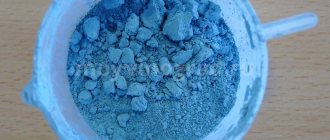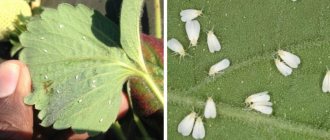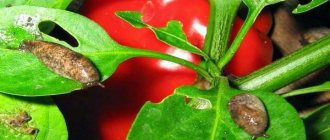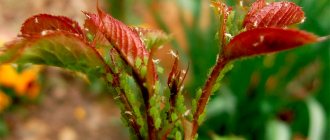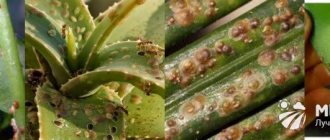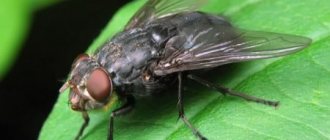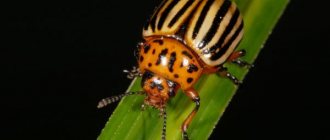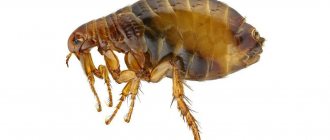Home Diseases and pests
Raspberry pests are insects common throughout the European territory of the country, a description of which can be found in this article. The development of effective ways to eliminate them is ongoing, since some means are outdated due to the excellent adaptation of pests to them. Finding out about raspberry pests and fighting them is only half the battle. It is important to start all agricultural activities in a timely manner. There is a division into events that should be held in spring, summer and autumn. How to detect and neutralize this or that insect in your garden is described in this material. Detailed descriptions are accompanied by visual illustrations. It also shows how to identify hidden colonies of pests in raspberry plantings.
- 2 How to treat raspberries against the earwig pest in the fall?
- 3 How to spray raspberries in the spring against pests of motley fillies?
- 4 Treatment of raspberries in summer against kelevik pests: how to fight
- 5 How to protect raspberries from the red bug pest: fight in spring
- 6 Pests of remontant raspberries in spring: description with photographs
- 7 Pests of raspberry beetles: photos and their treatment
- 8 Raspberry pests in pictures and how to combat them
8.1 Video: Controlling raspberry pests without chemicals
Treatment of raspberries from pests in autumn for winter
Treating raspberries against pests helps prevent the appearance of various mites that suck the juices from the plant. Most often, it is recommended to treat raspberries for pests in the fall, since most mites successfully overwinter in fallen leaves. Read on to learn how raspberries are treated against pests in the fall for the winter - the two most common types of mites are discussed.
Look at what common raspberry pests look like in the photo and continue to study the diversity of their species:
Raspberry mite
Raspberry mite Eriophyes gracilis Nal. - a very small pest, cylindrical in shape with two pairs of legs. Mites live and feed in leaf tissues, making moves and sucking out sap. In feeding areas, irregularly shaped bulges and folds form on the leaves - galls. The folds on both sides of the leaf blade are numerous, initially yellow-green, later becoming discolored. The veins of the affected leaves are severely bent, the leaf blades are deformed, lighten and dry out prematurely. Adult mites overwinter under the bud scales; in the spring, when they bloom, they penetrate into young leaves and feed on tissue sap. Over the summer, several generations of ticks develop.
Control measures. Preventive spraying when leaves fall in the fall with one of the drugs: fufanon, kemif, actellik. Repeated spraying is carried out immediately after raspberry flowering with the same preparations.
Common spider mite
Common spider mite Tetranychus urticae Koch. - a very small pest that feeds on the sap of young plant tissues. Has 4 pairs of legs. The body is 0.25-0.43 mm long, oval, greenish-yellow or orange-red. Females overwinter under plant debris and under the bark of trees and shrubs. In the spring, young leaves colonize, feed, weave thin webs and lay eggs.
The larvae of each generation, depending on weather conditions, develop from 8 to 20 days. During the growing season, more than 10 generations of the pest develop in open ground. Damaged leaves turn yellow, become deformed, turn brown and dry out. In most cases, the mite spreads from nurseries with planting material, as well as with various cut flowers and potted indoor plants. This pest damages over 200 species of various plants, including honeysuckle.
Control measures. Spraying plants when a pest appears and without fail in the fall before winter with one of the preparations: Fitoverm, Fufanon, Kemifos, Actellik, Lightning.
Fungal diseases
Raspberry diseases are primarily caused by various types of fungi. By following a few basic tips we can avoid their attacks:
- Firstly, you can’t plant raspberries too thickly.
- Second, raspberries should be treated with an antifungal every spring before the flowers begin to develop.
- It is advisable to choose varieties that are resistant to certain diseases common in your area.
- If a disease is noticed, it is necessary to immediately get rid of the infected parts of the plant.
If you follow these recommendations and know the agricultural techniques for growing and caring for raspberries, you can count on a bountiful harvest every year. Below are the most common raspberry diseases with photos, their descriptions and treatment.
Powdery mildew
This is a fungal disease. Powdery mildew of raspberries causes inhibition of plant growth, reduced yield, and deterioration in its quality. The disease makes raspberries covered with powdery mildew unsuitable for consumption. The pathogen that causes the disease is a polyphage (a parasite of many plant species).
Symptoms:
- Initially, light green spots appear on the upper side of the affected leaves. Beneath them, on the underside, a coating forms, consisting of mycelium and the conidial spores that it creates. The photo below shows a mycelium on the underside of a leaf blade.
- Over time, a white coating forms on the upper side of the leaves. Sometimes small fruiting bodies of the fungus are observed in older places. At first they are yellow, over time they darken and become dark brown, mainly leaves are affected, less often buds, fruits, and shoots.
- Infected leaves develop worse and often bend upward.
- Shoots become infected mainly at the tops. Infected shoots develop worse, they are thin and long.
The pathogen overwinters on infected shoot tips, mainly in the form of mycelium. Infection occurs in a humid environment; for powdery mildew, morning dew or fog is sufficient.
Unlike most fungal diseases, the development of powdery mildew is favored by dry and sunny weather.
Prevention and control
The development of the disease is limited by a number of preventive measures:
- It is important to maintain the optimal distance between rows and plants in the row. The density of plants increases their susceptibility to fungal diseases. Excess young shoots should be removed.
- All infected shoots should be removed, as they are the source of infection.
- Do not exceed the correct doses of nitrogen fertilizers - their excess contributes to the development of powdery mildew.
- Spraying with dicarboximide fungicides, used to control gray mold, also reduces the development of raspberry powdery mildew. A more specialized drug is Topaz, EC (effective, low toxic for humans and bees).
Dying of raspberry shoots
The pathogen that causes this disease appears mainly on the leaves, shoots and buds of plants. It is not difficult to detect and diagnose.
Symptoms:
- The first symptoms are dark purple-brown spots at the base of the leaves and around the buds, appearing in the summer, usually in June.
- The spots spread quite quickly, covering the entire circumference of the shoot, this leads to peeling and cracking of the raspberry bark.
- As a result, raspberry shoots wither and dry out, young shoots die very quickly, and the greatest damage is observed in the summer, the next year after infection. If lesions form in the lower, above-ground part of the shoots, the latter can easily break.
The dieback is caused by fungi (Didymella applanata). The disease is also called Raspberry Purple Spot (Didymella) after the name of the fungus. Fungi live inside the shoots. Fungal spores often infect young branches. Most often, the infection enters the plant through damage to the bark. The disease often causes the death of young shoots, although it also weakens older branches, causing them to break even in light winds.
Prevention and treatment
Preventing and fighting the disease is not easy:
- If the plantation is just being established, you should choose varieties that are less susceptible to drying out of the shoots - Polka, Polyana, Pokusa.
- It is necessary to avoid planting plants too densely; bushes should be planted at a distance that provides ventilation.
- Watering is carried out at the root, without soaking the leaves.
- After harvesting the fruits from the plantation, cut off the two-year-old shoots that have produced fruit and all diseased plants.
- In areas especially susceptible to fungus, raspberries are sprayed in the spring, before flowering (preparations based on Pyrimethanil - Mythos 300 SC, Luna 300 KS).
- The last treatment is carried out after harvesting the fruits and pruning the shoots.
- If it is too late to save the plant, you should immediately cut off the affected shoots and take them far beyond the plantation or burn them.
To prevent and combat this raspberry disease, you can use the same measures as in the case of gray mold - we also use them at the beginning of the growing season (when young shoots reach a length of 20 cm) - Luna 300 KS. Repeat the treatments several times in the summer, with an interval of 10-14 days.
Anthracnose
The disease affects almost the entire plant at once. Young, weak shoots are most susceptible.
Symptoms:
- The shoots are covered with small oval, purple spots. The first signs on young shoots emerging from the soil can be detected at the end of May.
- As the infection progresses, the spots become white-gray with a red border. Clusters of spores are clearly visible, causing longitudinal cracks in the raspberry bark.
- A sign of anthracnose is the gray bark of the shoots.
- The leaves have small, round, gray spots with a purple border.
Raspberries affected by anthracnose quickly freeze in winter due to weakened bark.
Struggle
Raspberry anthracnose can be dealt with in the same way as shoot dieback:
- Selection of resistant varieties (Izobilnaya, Texas).
- Avoiding too high planting density.
- The soil under the bushes needs to be dug up to a depth of 10 cm. Weeds need to be destroyed.
- Moderate doses of nitrogen fertilizers.
- As a preventative measure, you can spray raspberries with Bordeaux mixture (1%) or its substitutes: the first time when the shoots reach a length of 15 cm, the second time before flowering, the third time after flowering.
- Spraying with fungicides containing thiophanate methyl and some triazoles (for example, tetraconazole - Domark, ME, Eminent, ME) and strobilurins (for example, trifloxystrobin - Zato, VDG). After harvesting, 2-3 more treatments with these drugs should be carried out.
- Trimming infected shoots and off-site disposal.
Gray rot
The pathogen affects all parts of the plant: flowers, fruit buds, fruits, shoots. Infected flowers turn brown and die.
Symptoms:
- The appearance of light brown spots on the shoots. When the shoot becomes woody, the spotted tissue turns gray and peels off. Affected shoots grow poorly and have reduced frost resistance.
- On infected raspberries, the disease manifests itself as spots of rotting, a white coating of mycelium appears on them, which is gradually covered with a gray dusty coating consisting of conidial spores. These spores promote further infections, so the pathogen spreads quickly from the infected fruit through contact with other parts of the plant.
- Young shoots infected with gray mold may die.
Photo. Gray rot of raspberries
Infected shoots are susceptible to freezing and die when gray rot affects most of them. The fungus hibernates or develops saprophytically on infected dead plant debris, litter and weeds, from where the plant becomes infected in the spring.
If gray plaque is observed, countermeasures must be taken as soon as possible. The disease may be asymptomatic until harvest, when the fungi begin to attack the fruit.
Prevention measures:
- It is necessary to choose varieties that are less susceptible to gray rot.
- The fungus is easily transferred to other plants and overwinters on bushes without problems. It is important to avoid too high planting densities. You need to trim off excess shoots.
- Avoid excessive fertilization with nitrogen.
- We avoid irrigating the leaves when watering; drip watering is preferable.
How to treat:
- First of all, we get rid of the infected parts of the plants, take them outside the site and dispose of them.
- For prevention, antifungal sprays are used at the beginning of flowering.
Recommended drugs to combat the disease:
- Signum, VDG;
- Teldor, VDG;
- Switch, VDG;
- But, VDG.
It is better to use the drugs alternately so that the fungus does not become resistant.
White leaf spot
This raspberry leaf disease is identified by the following symptoms:
- a characteristic feature on the leaves is white spots with a dark border;
- Leaves affected by spotting fall off.
Spraying against white spotting is carried out with the same preparations as for gray rot. Preventive measures, as with all fungal diseases, include low planting density, regular lightening pruning, moderate fertilization, and careful watering.
Raspberry verticillium
Another fungal disease of raspberry bushes that affects the underground parts of the plant and the above-ground parts of the shoots. Synonyms for the disease: verticillium wilt, verticillium wilt.
Symptoms:
- The first symptoms include small, irregularly shaped yellowish spots between the veins of the leaves. At this stage, the disease can develop and last for several years until suddenly in a certain year it destroys the entire crop.
- The hot period at the time of fruit set accelerates the development of pathogens. Suddenly, the edges of the leaves begin to dry out and the shoots die. The initial diagnosis of shoot dieback is similar to another disease called raspberry shoot dieback.
- A characteristic sign of verticillium is a bluish discoloration or blue-blue longitudinal change in the color of the woody parts of plants. This stage always ends with the complete death of the plant. Infected plants can live up to three years; individual shoots on a plantation or entire bushes can then die.
The photograph shows the symptoms of raspberry verticillium - small, irregularly shaped yellowish spots between the veins of the leaves.
Raspberry bushes growing in excessively wet areas with stagnant water in the autumn-spring period are most susceptible to infection with verticillium. Too much water stored in raspberry tissues affects the susceptibility of shoots and roots to frostbite, which makes the path of infection easier. In addition, verticillium is also accompanied by damage to the base of the shoots. The death of shoots occurs earlier in the current year; weakened plants are more often infected with other pathogens.
The occurrence of verticillium is favored by heavy soils with too much organic matter.
Some varieties are almost completely resistant to verticillium.
Fragments of diseased plants should be removed from the garden as quickly as possible and burned.
Chemical control of verticillium. The first treatment of raspberries against the disease is carried out when young shoots reach a height of 20 cm, continue spraying every 10-14 days until harvest, not forgetting the waiting period. If the disease reappears at the end of the spray cycle, spray the entire plantation several times after harvest.
Chemicals that eliminate and limit verticillium include:
- Rovral, JV;
- Luna 300, KS;
- Luna Experience, KS;
- Switch, VDG;
- Topsin-M, SP;
- Signum, VDG;
- Yamato, SE.
The best results are obtained when using several products during the growing season. Alternation of chemicals reduces the development of pathogen resistance to them.
Crimson Rust
The causative agent is the fungus Phragmium rubi-idaei. Raspberry rust occurs on varieties that bear fruit on annual and biennial shoots. The disease is favored by warm weather (18-21 °C) and high air humidity. Symptoms of rust appear on raspberry leaves and can also be observed on petioles, stems, and flowers.
Symptoms:
- At the beginning of May, the first signs of rust can be detected. Small yellow-orange growths resembling cups appear on the upper side of the leaves. These are clusters of spores.
- At the turn of July - June, the following clusters of rust-colored spores form on the underside of the leaves.
- In autumn, black spores form among the rusty spores.
- Heavily infected leaves fall off, weakening the bush. This leads to a decrease in frost resistance and deterioration in yield.
Prevention and control:
- Selecting varieties that are less susceptible to rust.
- Sparse, well-ventilated plantings. Excess shoots need to be cut out in time.
- Water at the root, without getting the foliage wet.
- After harvesting the fruits, cut off shoots that have already produced a harvest, two-year-olds and diseased shoots.
- The first plant protection treatment, if symptoms of the disease are noticed, can be carried out at the beginning of flowering.
In the fight against raspberry rust, it is recommended to use the following preparations before flowering:
- But, VDG;
- Systemic fungicide Luna Sensation, KS.
Fusarium
Fungi of the genus Fusarium can infect various parts of the plant, such as the base of the shoot, side stems or buds, causing Fusarium raspberry blight.
Symptoms:
- Fusarium shoot base blight appears as brown spots at the base of annual stems. Infected plants break off from the ground and die.
- Fusarium lateral shoots occur from the moment of their development. The first symptoms are brown spots between the veins of the leaves. Affected leaves quickly wither and dry out. Fruit-bearing side shoots also die off.
- It happens that wilting and drying of leaves is observed in early spring, soon after the buds open.
- Fusarium bud disease causes the death of two-year-old buds. The buds become infected in the fall of last year. Plants are infected through the soil in which the fungi overwinter.
- Symptoms of fusarium intensify under conditions of drought and high air temperatures. In damp weather, clusters of spores (pink, orange, yellowish) can be seen on the shoots.
- Fungi of the genus Fusarium attack the conducting vessels of plants, causing them to become blocked. Due to blockage of blood vessels, water does not reach some shoots or buds, which leads to their withering and drying out.
Struggle
There are no effective methods to combat fusarium. The disease can only be prevented:
- It is very important to carefully handle raspberry seedlings so as not to damage the roots and shoots, since any wounds facilitate the penetration of the fungus into the plants.
- Staking shoots to a trellis also prevents fusarium because it protects the shoots from breaking at the base, in places where fungi can often attack.
How to treat raspberries against the earwig pest in the fall?
Before treating raspberries for pests in the fall, you need to know that the common earwig Forfucula auricularia L. is a large insect 13-20 mm long. The body is narrow, the head is well separated, with a gnawing mouthpart directed forward. The insect has two pairs of wings, the front elytra are leathery, often underdeveloped or absent altogether, the wings, when folded, protrude from under the elytra in the form of short plates. At the end of the abdomen there are two hard appendages, running legs, with three-segmented tarsi. The transformation is incomplete; the larvae are very similar to adult insects, but smaller in size. Earwigs are nocturnal, hiding under leaves and branches or in crevices in bark during the day. They feed on both plant debris and vegetative plants, nibbling buds, young shoots, edges of leaves, petals, and internal parts of flowers.
Control measures. The first thing to treat raspberries against the earwig pest is an insecticidal preparation diluted according to the manufacturer's instructions. If the pest population is large, spraying is carried out with one of the drugs: Fufanon, Kemifos, Actellik, Inta-Vir, taking into account the waiting period.
Try varieties of large-fruited raspberries from a trusted supplier:
- Ruby giant - winter-hardy, medium-spreading raspberry bushes have a small number of thorns. The average weight of berries is 6-8 g, the maximum is 14 g. During the season, the bush produces from 4 to 5 kg of harvest, without requiring special care. The variety is resistant to typical pests and diseases.
- Early sweet is a powerful, semi-spreading, well-developed bush of Rubus idaeus Early sweet, reaching a height of up to 2 m. Thorny shoots grow at the base. The variety begins to bear fruit in June-July and is resistant to major diseases. The berries are juicy, sweet in taste with slight sourness and a strong pleasant raspberry smell. The shape of the fruit is round-conical, the weight of each berry is 6-8 g. From one bush you can collect 4-5 kg of fruit.
- Altai delicious - raspberry thickets from specimens of this variety can reach 2.5 meters in height. Per hectare, the crop produces from 3.5 to 6.5 tons of dense and juicy berries, which perfectly retain their taste even after culinary processing (cooking into jam or jam, grinding with sugar or honey, freezing).
- Tulameen is the result of the work of breeders from Canada, who in 1989 grew this variety based on Nootka and GlenProsen and named it after the Tulameen River. Raspberry bushes reach a height of 2 m. The fragrant dark pink fruits of the Tulamin variety have an oblong-conical shape and weigh 4-5 g. They have a very pleasant taste. Harvesting these berries is very simple: they are easily separated from the stalks without losing their shape.
- Glen Ample is a very popular standard variety. The height reaches 3.5 m. The shoots are powerful, practically without thorns, each with up to 30 fruit branches. High-yielding raspberries - 4-5 kg per bush, large berries 6-8 g, bright red, very sweet, dense. The variety is suitable for both personal gardens and farms, and for industrial cultivation.
Viral diseases
Fortunately, viral diseases of raspberries appear a little less frequently than fungal diseases, but they cannot be controlled. Currently used plant protection products cannot cope with viral diseases, so all that remains is to prevent their attacks.
First of all, you need to buy seedlings only from trusted nurseries. If we observe any pests (mainly aphids) that spread viral diseases, they should be destroyed immediately. Shoots or even whole plants infected with viral diseases should be immediately removed and disposed of (burned).
Mosaic
The disease affects the leaves.
Symptoms of raspberry mosaic:
- The leaves become covered with yellowish spots, the veins glow and turn pale.
- The leaf blade becomes deformed and curls, which slows down the growth of the bush and reduces the quality of the harvest.
- Affected shoots break easily, especially in the upper part.
Unfortunately, in most cases, bushes affected by the mosaic virus die within several seasons. The best prevention is to control aphids found on shrubs, since these insects are carriers of the mosaic virus.
Bushy dwarf virus
The disease affects cultivated and most types of wild raspberries. Infected plants produce low yields and very low quality. The fruits ripen unevenly, are deformed, and often fall apart when harvested. Some susceptible varieties may have fruit yields as much as 70% lower.
Symptoms:
- Characteristic symptoms of the disease are dwarf shrubs and their bushiness, caused by thin and weak shoots growing from dormant buds.
- The fruits ripen unevenly and crumble.
- In severe cases, growth slows down.
- Some varieties have leaf chlorosis.
The virus that causes the disease is spread with pollen to insects that pollinate raspberries. This makes it impossible to fight the disease. It is impossible to remove pollen. The development of the disease can only be limited by preventive measures:
- production of seedlings exclusively from healthy plants;
- examination of bushes and complete removal of plants even at the slightest symptoms of a viral disease.
Chlorosis
Chlorosis of the veins of raspberry leaves (Raspberry vein chlorosis virus) is manifested primarily by the appearance (mainly in summer) of chlorotic yellowish spots on the surface of the leaves and their veins. The disease first affects the leaves of young shoots. Then a more widespread yellowing of raspberry leaves occurs, the leaf plates become deformed and dry out at the edges.
Raspberry chlorosis is transmitted with planting material and spread by insects, usually aphids. As with mosaic, chlorosis can be prevented by controlling aphids, which carry the chlorosis virus and infect plants. Proven means of combating aphids are, for example, Mospilan, RP or Karate Zeon, MKS.
Raspberry varieties are resistant to chlorosis: Kolkhoznitsa, Russian Harvest. The varieties Marlboro and Usanka are highly susceptible to chlorosis.
How to spray raspberries in the spring against pests of motley fillies?
Before spraying raspberries against pests in the spring, you need to clarify that the variegated grasshopper Jassus mixtus F. is a small insect 6.5-7.5 mm long, with a wide pronotum and tetrahedral hind tibia densely planted with spines. The crown is rectangular, light yellow, rounded, in front with 6 points located transversely, behind them there are 4 or 2 more points. The forewings are brownish-yellow with many milky-white cross-veins and brownish-yellow merging spots and bands. It feeds on the sap of herbaceous plants and is often found on shrubs, including raspberries.
Control measures. Preventive spraying during leaf growth and immediately after flowering with one of the preparations: fufanon, kemifos, actellik, kinmiks, spark, Inta-Vir, actara, fitoverm. When choosing what to spray raspberries against pests, you need to take into account the potential risk to human health.
Rating of the best folk and chemical remedies for treating bushes
The use of effective drugs to protect raspberries from pests and diseases allows you to grow a healthy plant and maintain productivity at a high level.
Chemicals
To protect raspberries, gardeners often use various chemicals. When worms are detected in ripening berries and obvious signs of disease, gardeners often use:
- "Nitrafen";
- "Fufanon";
- "Chlorophos";
- "Nitrafen";
- "Nystatin"
The above drugs are very effective. They will reliably protect raspberries and preserve the harvest.
Traditional medicines
There are also gentle methods of combating various diseases. These are folk remedies. They are safe for plants and can be used not only in early spring, but also in summer.
Tar
To combat weevils, raspberries can be treated with tar. To do this, you will need a solution of a liter of water and 10 grams of birch tar. This treatment is effective in early spring.
Ammonia
Raspberries can be protected from aphids and other insects using ammonia. To do this, dissolve 50 ml of alcohol and grated laundry soap in 10 liters of water. Spraying is carried out 1-2 times a month.
Mustard and soda
You can protect raspberries from chlorosis, anthracnose and root rot with a mixture of mustard and soda. The solution will require 5 liters of warm water and 10 grams of dry mustard. The resulting solution is used to treat raspberries immediately after flowering. Mustard can be replaced with laundry soap and soda. This will require 50 grams of each substance and a bucket of water.
Bordeaux mixture
A solution of Bordeaux mixture will save damaged raspberries from most common diseases. For best results, plants are sprayed in the spring. During the flowering and fruiting period, Bordeaux mixture is not used. This can cause the berries to turn brown and crack.
Urea
To protect raspberries from anthracnose, spotting, rust, glass, and raspberry beetle larvae, you can use urea.
For 10 liters of water you will need 750 grams of urea and 50 grams of copper sulfate. Plants are treated with the prepared solution up to four times per season.
Boiling water
To combat kidney mites and aphids, boiling water is useful. They water the trunks and leaves of raspberries from a watering can in small quantities, being careful not to burn the root system.
Iron sulfate
During the flowering and fruiting period of raspberries, iron sulfate is used. It will help save the plant from fungal diseases and protect against insects. In addition, vitriol saturates the soil with iron and strengthens the immune system.
Copper sulfate
To treat various diseases in the summer, many gardeners use copper sulfate. To do this, 150 grams of the substance are diluted in 9 liters of water. The plant is thoroughly sprayed with a freshly prepared solution.
Treating raspberries in summer against kelevik pests: how to fight
Common spider mite
Before dealing with raspberry pests, Acanthosoma haemorrhoidalis L. , you need to understand that this is a large bug with a body length of 13-17 mm. The color is yellowish-green with small black dots, the abdomen, especially at the apex, is red, the first antennal segment is red, the prothorax spines are also red. The lateral angles of the pronotum are sharp and strongly elongated. The larvae are similar to adult insects, but smaller in size. They feed on the sap of the tissues of deciduous trees and shrubs.
Botanical description
The sinuous woody rhizome of raspberries forms many adventitious roots, due to which the raspberry root system becomes powerful and very branched. Erect stems reach a height of one and a half to two and a half meters. The shoots of the first year are herbaceous, juicy, bluish-green, covered with frequent, thin, small thorns. In the second year, the shoots become woody and brown, and after fruiting they dry out, but new green stems grow instead the following spring.
Raspberry leaves are petiolate, alternate, compound - with three to seven oval leaflets, the upper side of the leaf blade is dark green, and the lower side is whitish due to the fine hair growing on it. Small racemose inflorescences of white flowers about one centimeter in diameter are located in the axils of the leaves or on the tops of the stems.
The raspberry consists of small, hairy drupes that grow together to form a complex fruit. The most common varieties grown are red raspberries of various shades, but yellow raspberries and even black raspberries are also cultivated. After planting, raspberries usually begin to bear fruit the next year; in the first year, flower buds are just laid on its stems, from which then, from the next spring, fruit branches develop. However, today, thanks to the efforts of breeders, there are remontant raspberry varieties that bear fruit on the shoots of the first year.
- Grape varieties Talisman - why is it not as bad as they say?
Raspberries attract many insect pests that parasitize on them, and they also have many dangerous diseases. Proper planting and care of raspberries strengthens the plant's resistance to diseases and insect parasites. We will tell you not only about how to deal with raspberry enemies, but also about preventive measures that will protect your raspberry tree from the penetration of harmful insects and pathogens.
How to protect raspberries from the red bug pest: fight in spring
The fight against raspberry pests in spring begins immediately after the snow cover melts. Before you protect raspberries from the pest the common red bug, or soldier bug Pyrrhocoris apterus L., you need to know that this is a large sucking insect 9-11 mm long. The body is red, and the head, proboscis, legs, quadrangular spot in the middle of the pronotum, scutellum, clavus, membrane, 2 spots (small near the base, large in the middle) on the elytra, the top and bottom of the abdomen are black. The abdominal rim is red, the chest is black with red edges, the membrane is shortened. There are no simple ocelli; the first segment of the proboscis is almost equal to the length of the head. Insects with incomplete metamorphosis. Adult bugs and larvae overwinter in cracks in the bark of trunks, stumps, under fallen leaves among dry shoots of bushes.
In spring they come to the surface and form large clusters, visible from the sunny side. From May, females lay eggs on herbaceous plants; the hatched larvae feed on leaf sap until autumn. In the fall, bugs descend to the base of the trunk, for some time feed in large clusters on the shoots and grass, and as the temperature drops, they crawl into crevices in the bark for the winter. The red bug damages herbaceous plants, berry bushes and deciduous trees, especially linden and poplar.
Control measures. Preventive spraying in the spring, when the leaves bloom, with one of the drugs: fufanon, kemifos, actellik.
Saving the harvest
If the damage to the raspberry tree is small, you can fight it by mechanically removing the shoots
It is important to remember here that the affected stem is removed to a healthy area, occasionally cutting at the root
Why is it important? A raspberry shoot that is partially pruned will produce new fruit-bearing branches, and if you cut it at the base, this can cause the growth of basal shoots, which do not play a big role in the abundant fruiting of the raspberry bush. If more than 50% of the young stems are destroyed, it is no longer possible to cope only by removing the affected branches; you need to fight the pest using strong insecticides or completely destroy the planting
Complete destruction makes sense when the raspberry tree is old (usually 10-12 years after planting)
If more than 50% of the young stems are destroyed, it is no longer possible to cope only by removing the affected branches; you need to fight the pest using strong insecticides or completely destroy the planting. Complete destruction makes sense when the raspberry tree is old (usually 10-12 years after planting).
In other cases, you need to try to save the berry garden; control in this case consists of a complex of treatment with insecticides and mechanical removal of the affected parts of the plants.
Ways to fight
Comprehensive care and timely treatment with various therapeutic and prophylactic agents are very effective measures in the fight against raspberry fly. Remember that spraying with any chemicals should be carried out in complete calm, in the morning or evening, as well as during the day in cloudy weather. This is necessary in order not to provoke the appearance of sunburn on fragile plants:
- For preventive spraying of raspberries, you can use a solution of any insecticide that effectively fights the adult and larval stages of insects. For example, by diluting a tablet of the drug “Iskra” in a bucket of water. This is done in early spring, at the stage of bud swelling;
- if the shoots are already more than half affected, the bushes are sprayed with a solution of Actellik, Fitoverm, Confidor or Kemifos according to the instructions, at the interval specified for each specific drug. This option is the least preferable; you may not have to eat raspberry jam this year, but the raspberries will be saved;
- if there is a large volume of affected raspberry stems, it is recommended to complete pest control in the fall: treatment with one of the above anti-fly preparations is carried out in August, after harvesting.
Folk methods of combating raspberry fly involve using means to increase the resistance of plants and strengthen their natural immunity. And this makes sense: pests more often and in greater numbers infect sick, depleted plants.
We fight the raspberry fly using folk methods:
- treating the soil around raspberry bushes with Bordeaux mixture prevents the appearance of pests such as raspberry flies and sawflies. To do this, you need to dilute the prepared powder in an amount of 100 grams per bucket of water and in the fall, when preparing the bushes for wintering, pour it on the tree trunks;
- spraying raspberries with an infusion of tobacco dust or laundry soap against aphids, which secrete honeydew and attract adult insects. A solution of tobacco dust to combat it is prepared as follows: take a bucket of warm water for 300-400 grams of dust and infuse the solution for 24 hours. Soap solution for aphids on raspberries: rub a piece of laundry soap into a bucket of warm water, after dissolving, add a glass of wood ash and spray the plants.
To maintain raspberry immunity and for preventive purposes, regular feeding, mulching and thinning of plants is necessary.
Pests of remontant raspberries in spring: description with photographs
Raspberry pests in spring cause the greatest damage to the future harvest. Pests of remontant raspberries are especially dangerous, as they continue to damage buds, flowers and ovaries throughout the season. Next, we propose to consider the most common types of these insects.
Raspberry-strawberry weevil
Raspberry-strawberry weevil, or raspberry flower beetle Anthonomus rubi Hrbst. , - a beetle 2.5-3 mm long, black, sometimes with a brown tint, covered with thick light gray hairs. The proboscis is thin, slightly curved, the antennae are club-shaped. The larvae are grayish-white, curved, legless, with sparse hairs.
The weevil damages raspberries, strawberries, roses, as well as herbaceous plants from the Rosaceae family. Beetles overwinter under fallen leaves under raspberry and strawberry bushes. In the spring they come to the surface and feed on leaves, eating deep holes and small through holes in them. After additional feeding, the females lay eggs in the buds and gnaw the peduncle, causing the bud to break and fall off or remain hanging.
The larva develops inside the bud and pupates there. Young beetles emerge in the middle of summer and feed on young leaves until autumn, gnawing small holes in them. In the fall, the beetles go to winter. With a large number of weevils, the yield of berry crops, especially strawberries and raspberries, sharply decreases. The pest is widespread.
Control measures. Spring spraying of berry bushes when buds open and two weeks before flowering with fufanon or its analogues (kemifos, karbofos). When there is a large number of beetles in the summer, individual berry crops are sprayed with the same preparations. You can also use the drugs Kinmiks, Actellik, Iskra, Inta-Vir, taking into account the waiting period.
Fruit mower
Otiorrhynchus aurosparsus Germ. - weevil 7-9 mm long. The entire body above and below is covered with small round light golden scales and short hairs. The larvae are thick, legless, white, curved, with a yellowish head, and feed on the roots of herbaceous plants. The pupae are yellowish, open-type, with noticeable legs, wings and proboscis. In the spring, beetles gnaw out leaf buds and later flower buds of raspberries. The mower is polyphagous and causes great damage to berry bushes: raspberries, currants, gooseberries, as well as cherries and apricots.
Control measures. Preventive spraying in the spring, when buds open, with one of the drugs: fufanon, kemifos, actellik.
Study carefully these raspberry pests according to the descriptions with photographs, which are presented in large quantities further on the page!
What kind of white butterflies are around the raspberries?
If you encounter a large number of white butterflies that have chosen your raspberry patch as their temporary place of residence, then most likely there is an outbreak of the hawthorn butterfly population. This insect is a large daytime butterfly that feeds on flower nectar. The wingspan of the insect can reach 7 cm, the color of the wings is white with bright black veins, the chest and antennae are club-shaped.
A sharp increase in the number of insects occurs in waves, approximately once every 3-4 years; this natural process is associated primarily with climatic conditions. For the development of hawthorn, moisture is required; during dry periods, most of the butterflies die. In addition, this species of butterfly is susceptible to many diseases, so multiple growth has not been observed over several years.
The white butterfly itself is not dangerous, it does not damage plants and cannot affect the yield for the worse. The danger comes from the larvae deposited by it, from which the caterpillars hatch. But the caterpillars, in the process of their development, eat up the buds, and then the leaves and flowers. If you have encountered leaves in your garden that were only a “skeleton”, or the entire leaf plate was like a sieve, then these are precisely the consequences of the “work” of the white hawthorn butterfly.
For laying eggs, hawthorn primarily chooses pears, apple trees, and rowan trees, however, recently there have been reviews from gardeners that raspberries have increasingly begun to be attacked by insects. Perhaps this is due to the increasing spread of drugs against pests and diseases that are used on apple trees, plums, and cherries. Hands don’t always reach raspberries, so the butterfly chooses a place that is not so favorite and familiar, but at least harmless.
Pests of raspberry beetles: photos and their treatment
Pests of raspberry beetles Byturus tomentosus F. - an insect 4.5 mm long, grayish-yellow in color. The faces are up to 7 mm long, grayish-white, with brown plates on the back. The beetles overwinter in the soil and emerge to the surface in early May. They feed on the buds and growing leaves of raspberries, skeletonizing them. Females lay eggs one at a time in flowers and on green ovaries. After 10 days, the larvae hatch, gnaw into the receptacle and fruits, and feed for 40 days. Having completed their development, the larvae fall under the bushes and pupate in the soil; the young beetles remain in the soil to overwinter. Damaged berries quickly rot. Dense plantings in areas, the proximity of strawberry and raspberry plantations, a large number of pests - all this leads to the fact that the raspberry beetle constantly damages strawberry plantings. Moreover, the hungry beetles that have come to the surface are very attracted to the leaves of overwintered bushes.
Control measures. Compliance with all requirements of agricultural technology for growing this crop. Preventive spraying of bushes before flowering against a complex of pests also reduces the number of horseradish leaf beetles. If there is a large number of beetles and larvae in the summer, spraying is carried out after harvesting with one of the drugs: Fufanon, Kemifos, Kinmiks, Actellik, Inta-Vir - taking into account the waiting periods recommended for the drug used.
Who are pests and why are they dangerous?
Parasitic insects change the plant organism. Pests attack vegetative organs, being active at different stages of bush development. The destructive effect is the result of their feeding, movement in the soil, laying of larvae and eggs.
Parasites are dangerous for all parts of raspberries:
- Kidneys – external, internal nibbling, drying out. The buds turn black, turn brown, die, and are often contaminated with cobwebs and excrement. A sign of the vital activity of raspberry weevils, butterfly caterpillars, aphids, and mites.
- Leaves - holey, rough, figured eating, skeletonizing, twisting, folding. The leaf is the location of the web nests. The plates change color and become covered with swellings. A sign of cutworm caterpillars and other butterflies, beetles, weevils, fly larvae, aphids, and mites.
- Trunk, branches - eating away bark, eating away channels, cavities. The branches dry out and are reborn. Excrement and remains of plant tissue may spill out of the holes. Sign of weevil, raspberry beetle, stem fly, larvae, butterfly caterpillars.
- Generative organs - external and internal eating of buds, flowers, ovaries, fruits. Sign of beetles, weevils, butterfly caterpillars, moths, raspberry weevil larvae.
- Root part - gnawing on the neck is typical for cutworm caterpillars and beetle larvae. As a result, the roots wither and die.
Raspberry pests in pictures and how to combat them
There are other raspberry pests: the pictures below show individuals of both sexes. It tells about how the fight against them is carried out on a personal plot. Some are visible to the naked eye. Others can be recognized only by indirect signs of their presence.
Raspberry flea beetle Raspberry
flea beetle Batophila rubi is a small beetle with a body length of 1.4-2 mm, black with a blue tint. The beetle jumps well. It causes damage in July by skeletonizing leaves in the form of paths and small pits. Damages raspberries, less often honeysuckle. It occurs sporadically, so it does not cause much harm.
Control measures. Preventive spring spraying of bushes against a complex of pests with fufanon and its analogues also reduces the number of flea beetles. In case of large numbers, spraying is carried out in the summer.
The following shows these raspberry pests in pictures and the fight against them by spraying with insecticidal solutions:
Two-spotted lurker
Cryptocephalus biguttatus Scop . - a small beetle 4.5-6 mm long with a short stocky body. The head has a steep forehead and is pulled into the cervical shield. The elytra are black, with a wide red-yellow transverse spot at the apex. The legs, head and pronotum are black. In May-June it feeds on berry and ornamental bushes, gnawing young leaves.
Control measures. Collection and destruction of individual beetles, preventive and eradicative spraying with one of the drugs: fufanon, kemifos, actellik, spark, Inta-Vir.
Watch how raspberry pests are controlled in the video - the video demonstrates all the agrotechnical operations available to the gardener:
Video: Raspberry pest control without chemicals
Gall midges
Pests of this group can cause damage to different parts of plants and, depending on this, received the corresponding adjectives as a “prefix” to their name - for example, leaf or stem. However, they have the same essence. A small mosquito lays eggs in a suitable place on the plant, where its larvae subsequently parasitize, causing tissue swelling. The damaged plant weakens, slows down its development, and, if decisive action is not taken, dies.
Control measures
Damaged shoots are immediately cut off below the swellings that appear, and the damaged part of the plant is destroyed. The same applies to leaves with signs of disease. The bushes themselves are treated with Bitoxibacillin according to the instructions for currants.
Prevention
In autumn, the soil under the bushes is well loosened, and the leaf litter is removed and burned. Plants are pruned on time.
Controlling raspberry pests with folk remedies in autumn
Fighting raspberry pests with folk remedies ensures the purity of the future harvest. Next, let's look at those pests against which you can use safe home remedies. Typically, raspberry pest control is carried out in the fall and infusions of tomato tops, marigolds, and some other agents are used as insecticides.
Crimson nutcracker
Crimson nutcracker Diastrophus rubi Hart. - a small insect (2-3 mm) with a black body and thin abdomen. The larva is white, legless, 1.5 mm long. The larvae overwinter in large galls on the stems of raspberries and blackberries. In the spring they pupate there, and at the end of May adult insects emerge from the pupae. Females lay eggs on young green shoots. The hatched larvae feed on the tissues of the stems, causing tissue growth and the formation of galls. Damaged stems easily break and dry out, and the larvae inside the galls remain to overwinter.
Control measures. Timely cutting and burning of stems with galls.
Preventive spraying of bushes in the spring when leaves bloom with fufanon or kemifos. Folk remedies include dusting with tobacco dust. Raspberry fly
Raspberry fly Pegomyia rubivora Cog. (syn. Chortophila dentiens Pand., Hylemyia den-tiens Pand.) is a brownish-gray insect 5-7 mm long. The larva is dirty white, without legs, cylindrical in shape, the head is not separate. The eggs are white, oblong. The fly flies in May-June, feeding on the nectar of flowers and the sweet secretions of sucking pests. During the growth of green shoots, females lay eggs one at a time on the top and in the axils of growing leaves. The larvae, hatched after 5-8 days, immediately bite into the shoot and feed, boring a spiral or annular passage in the stem. The development of the larvae lasts 12-16 days, after which they go into the soil to a depth of 5-6 cm, make an oval puparia and remain there until the spring of next year. In the spring, the larvae pupate and after 7-9 days the flies begin to emerge. In hot weather, they emerge together within 10 days; in rainy weather, the emergence of flies lasts up to 20 days. In dense raspberry plantings, the fly damages up to 80% of young shoots. The tops of damaged shoots wither and droop, and dry out after two weeks. Lateral growing shoots do not have time to become lignified and most often do not overwinter. The raspberry fly also damages blackberries and meadowsweet.
Control measures. Spraying young shoots and soil before raspberry flowering during the flight of flies with fufanon or kemifos. Timely removal and burning of wilting shoots. Thinning of dense plantings and compliance with all requirements of agricultural technology for growing crops. The most effective folk remedy against this pest is laundry soap, on the basis of which a solution for spraying is prepared.
Raspberry stem
gall midge Lasioptera rubi Heeg . - a small mosquito 1.6-2.2 mm long. The body is black, the back is brown, covered with light yellow hairs. The wings are transparent, tender, the legs are yellow-brown. The larvae are 3-4 mm long, fusiform, legless, orange-yellow in color. The pupae are closed in cobwebby pseudocones. The larvae feed on the tissues of the shoots, causing the formation of tumors - galls measuring 3X2 cm. The larvae overwinter in the galls, each of which can contain from 2 to 11 pieces. In spring they pupate in separate chambers. Flight of adult insects is observed in May-July. Females lay 8-15 eggs on young raspberry shoots. After 8-10 days, microscopic larvae hatch and crawl under the bark, feed on tissue sap and cause the formation of galls.
Control measures. The same as against the crimson gallworm. Traditional methods are as follows: the tops of tomato bushes are sprayed with infusion.
Preventive measures to protect the bush
Carry out agricultural practices to avoid the use of chemicals. Preventive methods of protection:
- Do not plant raspberries after tomatoes, potatoes, strawberries - the community of pests will aggravate the infection.
- Practice autumn digging between rows and destroy weeds. Some of the larvae will fall to a depth from which they will not escape, while others will die on the surface.
- Thin out dense plantings.
- Burn plant debris, sprouts damaged by aphids, buds with larvae, weevil eggs, and stems damaged by flies.
- Lay mulch in a layer of 8 cm - after wintering it will be difficult for parasites to get to the surface.
- Carry out sanitary cutting of damaged sprouts. Remove lower fruit-bearing shoots, underdeveloped, weak, moth-damaged stems and galls.
- Shake off insects onto gauze shields and nets.
- Catch butterflies in containers with odorous baits and light traps.
- Plant dill, garlic, marigolds, and calendula in the rows.
5/5 — (1 vote)
Protecting raspberries from moths
The most common pests of raspberries are various types of moths. Protecting raspberries from pests of this type is quite difficult, since butterflies can migrate over considerable distances.
Little Raspberry Moth
The Little Raspberry Moth Stigmella aurella F. is a very small butterfly with thin lanceolate wings framed by a fringe of shiny hairs. Wingspan up to 5 mm. The head is covered with dense hairs, the first antennal segment is widened. The caterpillar is flat, legless, amber-yellow, shiny, with a dark brown head, feeds on the leaf parenchyma, making a mine. The mine is serpentine, sinuous, starts from the top of the leaf, then, twisting, ends at the midrib. The line of excrement is wide and intermittent. Two generations develop; the caterpillars feed and develop in July and October. The baby moth often damages blackberries.
Control measures. Preventive spraying of bushes before flowering and after harvesting with fufanon and kemifos.
Raspberry bud moth
Raspberry bud moth Incurvaria gibiella Bjerk. - a small moth with a wingspan of 11-14 mm. The head is yellow, the front wings are purple-brown, shiny, with yellow specks of varying sizes. The hind wings are gray with black silver fringe. The caterpillars are 7-9 mm long, red, with a black head and black pectoral and anal scutes. The pupae are brown, 5-8 mm long. Caterpillars overwinter in dense white cocoons in cracks in the bark, in stumps or under leaves under bushes. In early spring, caterpillars emerge and bite into the buds, closing the entrance with excrement. The caterpillar gnaws through the passage to the middle of the shoot, having finished feeding, pupates there or in a bud in a thin cocoon. Damaged buds dry out and can be identified by the wormhole protruding from them. The development of the pupae lasts several days, after which butterflies emerge from them. The flight of butterflies is observed during the raspberry flowering period. After fertilization, the females lay one egg in each flower. The hatched caterpillars feed on the fruit of the berries until they begin to ripen, then descend to the base of the shoots, weave a white cocoon and enter diapause until the spring of next year.
Control measures. Low cutting of old fruit-bearing shoots without leaving stumps, thinning and removal of weak underdeveloped shoots, removal of plant debris. Preventive spraying of bushes in the spring, when buds open, with fufanon and kemifos.
Single-colored raspberry moth
Single-colored raspberry moth Tischeria tagginella Hw. - a small butterfly whose caterpillar feeds on the leaf parenchyma, making a mine. The caterpillar is greenish with a black head. The mine on the upper side of the leaf is initially narrow, ribbon-like, then wide with irregular projections. The inside of the mine is lined with cobwebs, and there is a hole at the bottom for throwing out excrement.
Control measures. Preventive spraying of bushes when leaves bloom with fufanon or kemifos.
Where do the holes come from on raspberry leaves?
Leaf damage is an obvious sign of parasites. The perforated gnawing is often round, but can have a different shape and size. This is typical for black raspberry beetles, weevils, cutworm caterpillars, and glass beetles.
Important! Pay attention to window gnawing, when parasites scrape away the surface of the leaf, leaving the cuticle intact. As a result, something like a “window” is formed - an opening covered with a transparent film. Such damage is caused by butterfly and bud moth caterpillars.
Other raspberry pests
Next, we consider other raspberry pests found in home gardens.
Gray armyworm
The gray armyworm, or large gray armyworm Eurois occulta L. (syn.Agro-tis occulta L.) , is a large butterfly with a wingspan of 40-42 mm. The forewings are brownish-gray with a bluish tint, whitish transverse lines and a white ring-shaped spot. Near the end of the wings there is a wavy line, partly breaking up into wedge-shaped spots of black color. The hind wings are brown-gray with white fringe. The caterpillar is large, thick, 60-66 mm long. Its back is dark brown, with four transverse white warts on each segment and yellowish dorsal and paradorsal lines, from which oblique lines extend. The sides of the caterpillar are yellowish-brown, with a dark-brown spotted line with white dots and a yellow stripe with reddish spots. Brown pupa. The development and feeding of caterpillars occurs in May. The armyworm damages raspberries, blueberries, rosehips, many shrubs and herbaceous plants.
Control measures. Preventive spraying of bushes in the spring when leaves bloom with one of the preparations: fufanon, kemifos, actellik, kinmiks, spark, Inta-Vir.
Blackish garden armyworm
The blackish garden armyworm, or bitter armyworm Mamestra persicariae L., is a butterfly with a wingspan of 42-45 mm. The forewings are almost black with a violet or bluish tint, with black transverse stripes and an indistinct wavy line. The hind wings are grayish, with a wide border. Caterpillars are up to 40 mm long, gray-green or brown, with a dark chest shield and three light lines, a yellow head with a reticulate pattern. On the 11th segment of the body there is a velvety green dark tubercle. In the middle of the back there is a narrow yellowish line, on the sides of which on each segment there are dark oblique strokes rounded at the back in the form of wedge-shaped spots. The pupa is dark brown with a reddish tint. Feeding and development of caterpillars is observed in August-September. The caterpillars are polyphagous and damage the leaves of fruit and forest crops, berry bushes and various herbaceous plants. They cause great harm to fruit nurseries and seedlings, completely gnawing off the leaves.
Control measures. If there are a large number of caterpillars, spray with one of the following drugs: fufanon, kemifos, actellik, kinmiks, spark, Inta-Vir.
Golden raspberry cutworm
Golden raspberry cutworm Xanthia fulvago L. - a night butterfly with a wingspan of up to 33 mm. The caterpillars are gray-brown with a white line on the back, a gray lateral stripe and blackish oblique lines. It feeds in May, eating buds and blooming young raspberry leaves.
Control measures. Preventive spraying of bushes when leaves bloom with one of the preparations: fufanon, kemifos, actellik.
Brown-gray garden cutworm
Brown-gray garden cutworm Mamestra sop-tigua Schiff. (syn. Polia contigua Vill.) - a night butterfly with a wingspan of 40-42 mm. The forewings are brown-gray with indistinct spots. The hind wings are light gray. The caterpillars are yellow-green or reddish-yellow with a reddish line on the back, with oblique lines of the same color and one light stripe on the sides. The pupa is dark, red-brown. The flight of butterflies is observed in June-July; after fertilization, the females lay eggs on the leaves of plants. The hatched caterpillars feed and develop in August, gnawing on leaves. Having finished feeding, the caterpillars pupate in the soil. One generation develops. The armyworm damages raspberries, blueberries, and is found on deciduous trees, shrubs and herbaceous plants.
Control measures. If there are a large number of caterpillars, spray after picking berries with one of the following preparations: fufanon, kemifos, actellik, kinmiks, spark, Inta-Vir.
Girl Bear Girl
Bear Callimorpha dominula L. is a nocturnal moth with a wingspan of 45-55 mm. The wings fold over the back in a roof-shaped manner in the form of a triangle. The forewings are bluish-black with small and few white and yellow rounded spots, the hind wings are red or orange with black spots along the edge, sometimes large and merging. The caterpillars are 37-40 mm long, black-blue with blue-gray warts and yellow stripes, covered with fine hairs. Adult caterpillars have spots on the back and sides. The caterpillars feed in September-October and after wintering in May. They damage the leaves of strawberries, raspberries, and nettles, and are found on willows and poplars.
Control measures. Preventive spraying of bushes when leaves bloom with one of the following preparations: fufanon, kemifos, actellik, kinmiks, spark, Inta-Vir.
If the number of caterpillars is large, spraying with the same preparations is carried out in the fall. Blackish fathead
Blackish fathead Hesperia sao Hb . - a small dark brown butterfly with a wingspan of 18-20 mm. The head is large, the antennae are black and club-shaped. White spots are clearly visible on the dark brown wings; the underside of the wings is brown with light veins. The caterpillar is 16-20 mm long, dark brown with light dots, the head is black, densely covered with hairs. Caterpillars overwinter in rolled raspberry and blackberry leaves. They pupate in the spring and butterflies emerge in May. After fertilization, females lay eggs on young leaves. The hatched caterpillars feed on leaves, gluing them together with cobwebs, just like leaf roller caterpillars.
Two generations develop in a year. First generation butterflies fly in May-June, second generation butterflies fly in July-August. The caterpillars feed in June-July and September-October, damaging raspberry and blackberry leaves in dense plantings.
Control measures. Preventive spraying of bushes when leaves bloom with one of the following preparations: fufanon, kemifos, actellik, kinmiks, spark, Inta-Vir. If there are a large number of caterpillars, spray with the same preparations after picking the berries.
- Author: Tatyana
Rate this article:
- 5
- 4
- 3
- 2
- 1
(15 votes, average: 4.1 out of 5)
Share with your friends!
What are the seasonal processing methods?
The type of measures depends on the stage of plant development. Consider which parasites and diseases are active during a certain period of the year, and use the appropriate method. Fighting methods are divided into three categories.
The first is agrotechnical measures that increase the productivity of the berry garden. The second is biological methods aimed at attracting predatory mammals, insects, and the use of drugs from pathogenic microorganisms. The third is chemical treatment using pesticides.
How to treat the plant in the fall?
At the end of the season, parasites seek shelter for the winter. The plant organism needs special protection. Processing in October-November:
- spray the bushes with Karbofos emulsion 0.1-0.2% or 1% Bordeaux mixture;
- dig up the soil, remove plant debris and fruit-bearing branches;
- collect nests of parasites, dry fruits, traps. Burn along with the cut shoots.
How to deal with bugs in the summer?
In June-July, cut out damaged shoots entirely and burn them. When the plant has fully grown green mass, take measures against leaf-eating parasites (gall midges, beetles, mites). Treat against anthracnose, powdery mildew, and all types of spotting. In August-September, after picking the berries, spray the bush with systemic preparations Horus and Actellik.
Features of spring processing
In April, dig up the soil with a shovel full and remove the weeds. Spray the raspberries before the buds open at 12 degrees. Spray the preparations on the bushes and in the tree trunks.
What to do in the “green cone” stage:
- Remove overgrown buds and burn them - mites have settled here. Pour hot water from a watering can over the kidneys;
- against gall midges use 1% Bordeaux mixture. Raspberries will receive protection from various diseases;
- for flies and beetles, take Karbofos 0.1-0.2%.
Pay attention to the lower part of the sprouts up to 15 cm tall. They actively contact the ground and collect a maximum of parasites.
What to do in the “pink bud” stage when the petals fall:
- against raspberry flies use Actellik (10 l/15 mg). Consumption – 1.5 l per 10 sq.m.;
- Kinmiks (10 l/2.5 ml) is used against bud moths;
- against gray rot, ulcerative, purple spotting, take Privent, Bayleton (0.2 g/l).
Table No. 1. Protecting raspberries from insects
| Parasite | Pesticides | Term | Biological products | Term |
| Weevil | Spark double effect, Emulsion of karbofos 0.3%, Inta-vir, Fufanon, Alatar KS, Kinmiks KS | Before flowering. August - after picking berries, during the development of a new generation of young individuals | Mospilan, Actofit, Lepidotsid | Vegetation |
| Raspberry black beetle | Karbofos emulsion 0.2%, Iskra double effect, Alatar KS 0.2%, Fufanon, Kinmiks KS | Before laying eggs. When protruding buds | Mospilan, Aktofit | Vegetation |
| Bud moth | Karbofos emulsion 0.3%, Iskra double effect, Kinmiks KS, Fufanon | Abundant irrigation in April before buds open. Work along the areas of the lower part of the shoots. When caterpillars migrate from wintering areas to swelling buds | Mospilan, Lepidotsid, Actofit | Vegetation |
| Gallica | Aktellik, Alatar, Spark double effect, Kinmiks CE, Fufanon | Flight, laying eggs | Aktofit, Fitoverm | Vegetation |
| Stem fly | Karbofos emulsion – 0.3%, Iskra double effect, Kinmiks KS, Fufanon | Before flowering, during the flight of flies, spray the soil and young shoots | Aktofit | Vegetation |
| scoop | Karbofos, Spark double effect, Inta vir, Fufanon, Actellik, Kinmiks KS | In May, preventive irrigation when leaves bloom. To eliminate caterpillars after picking berries | Mospilan, Lepidotsid | Vegetation |
| Spider mite | Colloidal sulfur 1-1.5%, Spark double effect, lime-gray decoction 0.5-1%, Fufanon, Karbofos emulsion 0.3%, Kinmiks KS, Metafos, Actellik | Before the buds open | Vermitek, Fitoverm | Vegetation |
| Aphid | Phosfamide emulsion 15%, Iskra double effect, Karbofos emulsion, Actellik 0.3%, Fufanon, Kinmiks KS | Development of larvae from eggs, infection of opening buds. | Mospilan, Aktofit, Fitoverm | Vegetation |
| Nitrafen solution 3%, DNOC solution 1% | Before buds open, in October after leaves fall | |||
| Glassware | Karbofos, Kinmiks KS, Iskra double effect | In the spring, before the buds open | Mospilan, Nemabact | Vegetation |
Raspberry stem fly and aphid
The stem fly lays eggs in the spring, in May. Afterwards, the larvae gnaw tunnels in the young shoots and burrow into the ground. It is recommended to dig up the soil in the fall, while generously sprinkling the soil with ash.
Green aphids live in colonies on raspberry leaves. Treat raspberry leaves with decoctions of herbs - calendula, tansy, or tobacco, adding a few tablespoons of laundry soap.
A garden is not only a place for harvesting, but also a lot of work. Caring for raspberries begins in early spring - the bushes are watered with boiling water to remove the weevil.
In the spring, spraying is carried out not only with insecticides, but also with preparations for the ovary. In the summer, they make sure that there are no caterpillars, midges, or mosquitoes. In the fall there is pruning and fertilizing. By strengthening the immunity of raspberries with various fertilizers, you can get an excellent harvest of healthy berries.
Ticks
In addition to the raspberry mite (Eriophyes gracilis), which “specializes” on plants of the genus Rubus, these crops can also be attacked by other mites. Most often, they colonize the underside of young leaves, which subsequently become bent, and light spots appear between their veins. At the same time, the bushes of the crop grow poorly.
Most often, ticks attack shrubs in dry weather.
Control measures
Spraying with Bitoxibacillin (according to the instructions for roses) and Fitoverm (according to the instructions for currants).
Prevention
To prevent the appearance of mites, it is important to follow the watering regime for raspberries and blackberries. In order to avoid rapid evaporation of moisture, shrubs are watered at dawn or in the evening (after sunset). In addition, in hot weather, the crowns of the bushes are irrigated with clean water.
